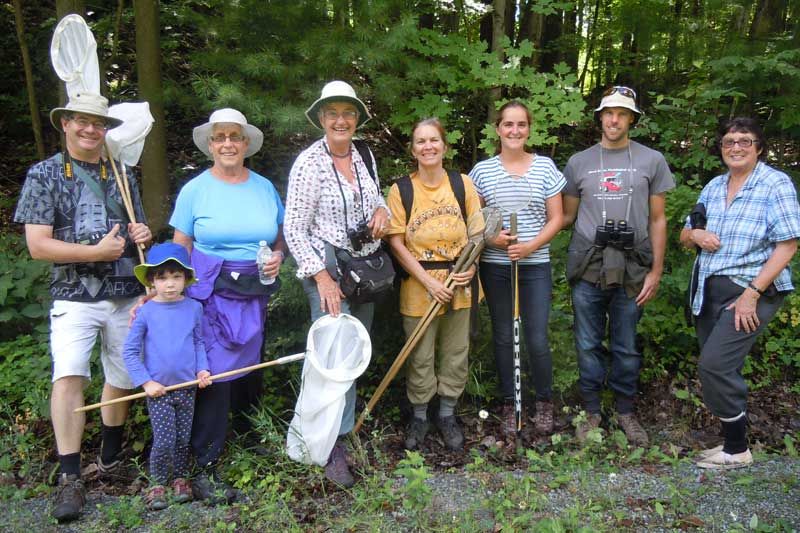Aug 08, 2013
Due to a request by members of the Desert Lake Cottage Association, board member Kate Laird headed up a Bio-Blitz near Desert Lake on August 3. Laird, who also sits on the board of the KLF&A Land Conservancy and who is a property owner on Desert Lake, was joined by Anne Robertson, coordinator of the Kingston Field Naturalists’ Youth Program, which she has been running for 40 years. Their Saturday Blitz took place at the Bailey/Sutherland Conservation Reserve, which is part of the Nature Conservancy of Canada and it is located on Canoe Lake Road near Snug Harbour and Mitchell Creek.
The small group that took part ranged in age from preschoolers to seniors and the group ventured into three different habitats on the reserve, which included meadowlands, deciduous and coniferous woodlands and wetlands. Armed with nets and small plastic containers, the group found and recorded all kinds of flora and fauna that they encountered while witnessing first hand the incredibly diverse ecosystems that exist in the lands that surround Desert Lake.
The purpose of these Bio-Blitzes is to create awareness by educating residents about the complex ecosystems that exist around them. “It's important that people understand how important bio-diversity is”, Robertson said when I met up with the group following their hike. “We hope that by providing awareness and education, more and more residents will come to appreciate the nature that surrounds them and as a result be more apt to protect and care for the land,” she said. Regarding the property that they had just hiked, Robertson said, “ It was very good. We did not for example see a lot of garlic mustard, an invasive species that kills a lot of the important fungal roots in the soil, which all trees need to help them to grow.”
The group also reported seeing various moths and butterflies, countless species of dragonflies, a millipede, a painted turtle, numerous fish and tadpoles, frogs and a huge number of plant, grass and tree species, including over 16 species of ferns. Laird said she was pleased to have Anne leading the group as she was able to inform them about a number of interesting facts, like the differences between a millipede and centipede. The difference is not just in their number of legs - millipedes are herbivores and have two pairs of legs per segment while centipedes are carnivores and have one leg per segment. Robertson also pointed out the differences between the numerous pink-flowered plants the group saw, like purple loosestrife, swamp milk weed, steeple bush and Joe Pye Weed, as well as the difference between three-leafed plants like hog peanut, ash seedlings and poison ivy. She also identified the bulbed timothy grass, which is a favorite snack for meadow voles, which are in turn a favorite snack for owls. “We had one gentleman who did not know much about this environment and he was amazed at the abundance of life in these lands,” Laird said. ”You tend to not notice the incredible diversity unless you take the time and look very closely and Anne was really able to help us see the amazing abundance of life here.”
The group came armed with clear plastic berry containers which Anne said are great for holding butterflies and moths long enough to be identified, after which they are released. They also brought along a number of lidded plastic containers to hold fish and tadpoles that the group caught and identified at one of the beaver ponds on the property. Robertson also came armed with a butterfly guide book put out by the Kingston Field Naturalists, which helped her to identify the numerous butterflies and moths that the group came across.
More Stories
- Latest CUPW Job Action Stops Postal Delivery Of The Frontenac News Forcing Alternate Plans
- Opponents of Barbers Lake Gravel Pit Pack Ag Hall in McDonalds Corners
- Bobsleigh Olympian Jay Dearborn At Mikes Pizza In Sydenham
- The Loins Club Of and O'Lakes Roar
- North Frontenac Back Roads Studio Tour - September 27 and 28
- Sunday Market Vendors Give Back
- George Street Work As Town Hall Renovation Nears Completion
- One Way Street Plan Hits A Dead End - Central Frontenac Council, September 9
- Global Gardening
- No Winner Yet in Catch The Ace But Fundraising Target Met

